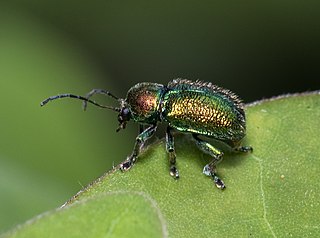Colaspoides is a genus of leaf beetles in the subfamily Eumolpinae. It is one of the largest genera in the subfamily, containing over 260 species worldwide. It is an extant genus but there is at least one species, C. eocenicus, found in Baltic amber from the Upper Eocene of Russia, and the genus has also been reported from the Miocene of the Dominican Republic.

Macrocoma is a genus of leaf beetles in the subfamily Eumolpinae. It contains about 100 species, which are found in tropical Africa, around the Mediterranean, on the Canary Islands, in western and central Asia, and in India.

Eumolpini is a tribe of leaf beetles in the subfamily Eumolpinae. It is the largest tribe in the subfamily, with approximately 170 genera found worldwide. Members of the tribe almost always have a longitudinal median groove on the pygidium, which possibly helps to keep the elytra locked at rest. They also generally have a subglabrous body, as well as appendiculate pretarsal claws.

Typophorini is a tribe of leaf beetles in the subfamily Eumolpinae. The tribe contains approximately 100 genera, which are found worldwide. Members of the tribe are mainly characterized by notches on the tibiae of the middle and hind legs, which are sometimes referred to as antenna cleaners. They also generally have a subglabrous body, as well as bifid pretarsal claws.
Hyperaxis is a genus of leaf beetles in the subfamily Eumolpinae. It is distributed in East and Southeast Asia.

Rhyparida is a genus of leaf beetles in the subfamily Eumolpinae. It is distributed in the Australasian and Indomalayan realms, though some species are also known from the African islands of Madagascar and Seychelles.
Tricliona is a genus of leaf beetles in the subfamily Eumolpinae. It contains at least 35 species, and is distributed from India and Southern China to the Philippines and New Guinea.

Abirus is a genus of leaf beetles in the subfamily Eumolpinae. It is distributed from the Malay Archipelago to the Indian subcontinent, China, and the Ryukyu Islands. The genus was first established by the Belgian entomologist Félicien Chapuis in 1874, as a split of Dermorhytis.
Eryxia is a genus of leaf beetles in the subfamily Eumolpinae. It is distributed in Africa and Western Asia.
Pagria is a genus of leaf beetles in the subfamily Eumolpinae. It is known from Africa, Asia and Australia.
Goniopleura is a genus of leaf beetles in the subfamily Eumolpinae. It is found in Southeast Asia. It is sometimes treated as a subgenus of Aulexis.
Cleoporus is a genus of leaf beetles in the subfamily Eumolpinae. It is known from Asia.

Fidia is a genus of leaf beetles in the subfamily Eumolpinae. It is distributed in East Asia, Southeast Asia and Africa.
Iphimoides is a genus of leaf beetles in the subfamily Eumolpinae. It is distributed in southeastern Asia and southern China.
Phytorus is a genus of leaf beetles in the subfamily Eumolpinae. It is distributed in Southeast Asia.
Trichotheca is a genus of leaf beetles in the subfamily Eumolpinae. It is distributed in South Asia, Southeast Asia and Southern China.
Parascela is a genus of leaf beetles in the subfamily Eumolpinae. It is distributed in Asia. The genus is placed close to Basilepta. According to Romantsov and Moseyko (2019), however, the differences between Parascela and Basilepta are unclear, and Parascela can probably even be considered a species group within Basilepta.

Euryopini is a tribe of leaf beetles in the subfamily Eumolpinae.

Bromiini is a tribe of leaf beetles in the subfamily Eumolpinae. The tribe contains approximately 120 genera, which are found worldwide. They are generally thought to be an artificial group, often with a subcylindrical prothorax without lateral ridges and covered with setae or scales.







